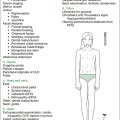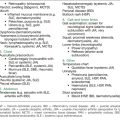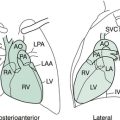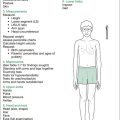Chapter 11 Neonatology
Short Cases
The neonatal examination
A thorough perinatal examination is the most commonly performed systematic assessment in paediatric practice. All medical undergraduates, graduates and paediatric postgraduates should be able to perform a thorough ‘baby check’. If there is ever a shortage of children with impressive signs around examination time, there is always a ready supply of neonates in level 2 nurseries, ideally suited to having a comprehensive baby check performed. The examination is standard irrespective of the gestation of the infant, although the interpretation of neurobehavioural findings requires a thorough knowledge of the variations between different gestational ages. The gestational age can be assessed by the Ballard method; this is indicated where the gestational age is in doubt, but is fairly complicated and not covered in this section. The object of this section is to provide a framework for the perinatal examination that is easy to remember. Only a limited sample of possible findings is given here, as a comprehensive discussion could double this book’s extent. Entire books can be, and have been, devoted to the examination of the newborn.
After listening to the heart, listen to the chest and then palpate the abdomen and the femoral arterial pulsations in particular. Then re-inspect, checking the baby from head to toe, but leave the less pleasant aspects until later (such as checking the mouth and palate with a spatula, checking the red reflex when the baby will not open his or her eyes, checking the hips). A detailed approach is given below.
• The cardiovascular system, particularly the heart and pulses for any evidence of cyanosis, murmurs, left-sided obstructive lesions or failure.
• The central nervous system, fontanelles and sutures.
• The skin, for jaundice, evidence of dehydration (skin turgor) or rashes.
• The umbilical cord, for any signs of infection (omphalitis).
Inspect: growth, colour, respirations, posture, movements, cry
The initial thorough examination commences with inspection. Note the baby’s weight, length, head circumference and nutritional status (muscle bulk, fat). Note the colour (peripheral cyanosis is common) and the respiratory rate (normal being 40–60 breaths per minute; periodic breathing is normal) and depth (retraction indicates some respiratory distress). Causes of tachypnoea include primary respiratory disorders (e.g. hyaline membrane disease, transient tachypnoea of the newborn, meconium aspiration, congenital pneumonia, pneumothorax), space-occupying lesions (e.g. diaphragmatic hernia, congenital cystic lung lesions) or non-respiratory systems: cardiac (e.g. shunts, left-heart obstructive lesions, myocardial disease, arrhythmias), metabolic (e.g. hypoglycaemia), infective (e.g. septicaemia) or haematological causes (e.g. anaemia, polycythaemia). Stridor may be noted with upper airway obstruction. It may be purely inspiratory if the obstruction is extrathoracic, and may involve expiration if intrathoracic. The causes are usually divided into site, intraluminal (e.g. meconium, mucus, blood or milk), intramural (e.g. subglottic oedema from overenthusiastic tracheal suctioning) or extramural (e.g. vascular ring). For more details, see the short case on stridor in Chapter 15 (The respiratory system).
Posture, quality of movement and nature of cry are noted. The gestation of the infant must be considered with respect to posture. Normal full-term neonates usually lie with their hips abducted and slightly flexed, their knees flexed and their upper limbs adducted, with flexion at the elbow and clenching of the fists (not tight), with fingers covering the thumb. Term babies with significant hypotonia may lie with their hips and thighs in the ‘frog’s legs position’ (see the floppy infant case in Chapter 13, Neurology). Babies with serious intracranial pathology may lie with extended necks (opisthotonic posture), obligate flexion of thumbs or scissored lower limbs. Very premature infants (less than 30 weeks) normally have minimal flexor tone, like a rag doll; by 34 weeks, flexor tone appears in the lower limbs, and by 36 weeks in the upper limbs as well. A formal gestational assessment should be undertaken if the gestation is in doubt and the infant seems hypotonic, so as not to overinterpret normal findings of prematurity.
Normal movements may include alternating movements in all limbs, myoclonic jerks when asleep (sleep myoclonus) and jaw tremors when crying. Paucity of movement can occur in neuromuscular diseases (see the floppy infant case in Chapter 13). Involuntary movements can include tremulousness or ‘jitters’ (which can be stopped by gentle pressure) and seizures (may be subtle, tonic or more often focal, irrespective of the underlying pathology, and cannot be stopped by pressure, clearly differentiating them from jitters). Jitters can occur with hypoglycaemia, hypocalcaemia, sepsis and neonatal abstinence syndrome (NAS). Seizures can be due to neonatal encephalopathy (formally termed hypoxic ischaemic encephalopathy), intracranial haemorrhage, meningitis, metabolic causes (hypoglycaemia/hyponatraemia/hypocalcaemia/hypomagnesaemia; hypernatraemia/hyperammonaemia; kernicterus, various inborn errors, pyridoxine deficiency), developmental brain disorders and NAS, or can be idiopathic.
Systematic examination: head to toe
Head, neck and upper limbs
The neck is then inspected for redundant skin posterolaterally, or ‘web neck’ (Noonan and Turner syndromes), and checked for any masses (e.g. lymphatic malformation or ‘cystic hygroma’) or fistulae (e.g. branchial), asymmetry (transient as in persistent fetal posturing; permanent as in the maldeveloped cervical vertebrae of Klippel–Feil syndrome) and range of movement (torticollis from sternocleidomastoid fibrosis/tumour).
Check the hands, forearms and arms from a dysmorphic viewpoint (see the case on the dysmorphic child in Chapter 9, Genetics and dysmorphology).
Abdomen and genitalia
Ambiguous genitalia may represent virilised females (e.g. congenital adrenal hyperplasia [CAH], aromatase deficiency), inadequately virilised males (e.g. testicular defects, disorders of androgen production or action) or chromosomal defects. Take particular note of the phallus size, the position of orifices, labioscrotal fusion, pigmentation (CAH) and whether any gonads are palpable. For more detail, see the short case on ambiguous genitalia in Chapter 7 (Endocrinology). The baby’s anus must be evaluated for patency and position.
Hip examination
The hip examination is most important—to detect developmental dysplasia of the hip (DDH, previously called congenital dislocation of the hip [CDH]). DDH can be difficult to detect on just one examination, even for very experienced clinicians, as the femoral head could be enlocated on that occasion. Thus, examination of the hip should be re-performed after the initial assessment. Asymmetric skin creases in the buttocks may occur with DDH, but are not a reliable sign of this. Similarly, unilateral DDH can be accompanied by a weaker femoral pulse to palpation on the affected side, but this is uncommon.
There are two standard manoeuvres:
1. Ortolani’s test is to reduce a posteriorly dislocated femoral head. The middle finger is placed over the greater trochanter, with the hips and knees flexed to 90 degrees, the baby lying on a firm surface. With the knee in the palm, the thigh is gently abducted while the thigh is brought forward to enlocate the femoral head, which should (may) produce a ‘clunk’ of relocation.
2. Barlow’s test is to detect whether the femoral head can be dislocated. The pelvis is fixed with one hand (with the thumb over the pubic symphysis, and the other four digits behind the coccygeal area). The other hand firmly holds the thigh and adducts it gently downwards: in DDH, the head dislocates over the posterior lip of the acetabulum, with an accompanying ‘clunk’.
Nervous system and spine
This completes the neurological assessment. Testing of deep tendon reflexes is not required.
Skin
Vascular birthmarks are common, and there are two distinct types:
1. Vascular malformations, which are always present at birth (e.g. trigeminal distribution ‘port wine stain’ in Sturge–Weber syndrome, with accompanying angiomatous malformation of the brain) and will grow in proportion to the rest of the body.
2. Haemangiomata (e.g. ‘strawberry naevus’), which (usually) are not present at birth, and will grow out of proportion to the rest of the body for 24 weeks, then involute slowly, with 50% gone by 5 years. Haemangiomata are of concern in certain areas: for example, near the eyes (can block vision, causing amblyopia), ears (can block ear canal causing ‘auditory amblyopia’) or ‘beard’ region (may indicate underlying laryngeal involvement), and may need to be treated with corticosteroids or laser therapy. This is more likely an issue at the 6-week check.






